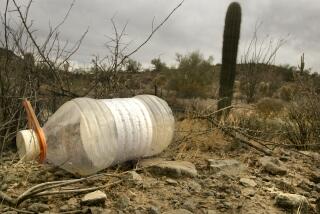DESERT SEAS : A Portfolio by Richard Misrach
- Share via
RICHARD MISRACH was born in Los Angeles in 1949. It was the ski trips as a teen-ager, however, those long drives up 395, that introduced him to the California desert. The place seemed desolate and dull then, a place to be gotten through on the way to someplace else. Later, in the ‘70s, his interests sparked by the visionary works and desert landscapes created by writers such as Carlos Castaneda, Misrach took a second look.
He’s been looking ever since, and the results have come to form an ongoing body of work Misrach calls the Desert Cantos. Selections from the series will be on display starting May 27 at the Jan Kesner Gallery in Los Angeles. The Cantos are what might be thought of as visual meditations upon “desertness,” a term meant to embrace not simply the geography but the marks men have placed upon it. The marks come in many shapes and sizes, some noble, some absurd. An ocean-like body of water shimmers in a ghostly mist. A mirrored surface reflects perfectly an empty sky. What might pass for some prehistoric lake is, in fact, the result of an old mismanaged irrigation project--the Salton Sea. The photograph, more than an aesthetic offering, becomes ironic as well, an invitation to meditate upon a landscape at once as fragile as it is foreboding.
When I think of my own discovery of the desert, I also think of a certain juxtaposition of images. I think of a trip I once made with my mother and grandfather. When I think of the trip now, I think of this: Near sundown, somewhere on the road out of Furnace Creek, we very nearly ran out of gas. Before that, earlier in the day, we had stopped on the outskirts of Baker and seen The Thing, The Mystery of the Mojave.
The Thing was little more than papier-mache and rabbit’s fur attached to a chicken-wire frame. We examined it in the semi-gloom of a clapboard shack while my grandfather pointed out the flaws in its construction. Then we walked back out into that great pool of heat and light and drank orange Nehis in the shade of a homemade billboard, awash in a silence profound enough to make any 8-year-old science-fiction buff think twice. The Mystery of the Mojave indeed. It was what trailed us into the night, down that lonesome stretch of blood-red asphalt where the gas gauge approached empty and a rising moon made snowdrifts of the dunes.
I was hooked, of course. Where else had such a relationship been struck between the absurd and the sublime? “The desert,” Richard Misrach writes, “may serve better as the backdrop for the problematic relationship between man and the environment. The human struggle, the successes . . . both noble and foolish, are readily apparent in the desert. Symbols and relationships seem to arise that stand for the human condition itself.” And so they do. A brightly painted gas pump breaks the surface of a man-made desert sea in a land where ground temperatures approach 200 degrees, where the thunder of returning space shuttles can rattle the chicken-wire bones of homemade aliens.
More to Read
The biggest entertainment stories
Get our big stories about Hollywood, film, television, music, arts, culture and more right in your inbox as soon as they publish.
You may occasionally receive promotional content from the Los Angeles Times.










